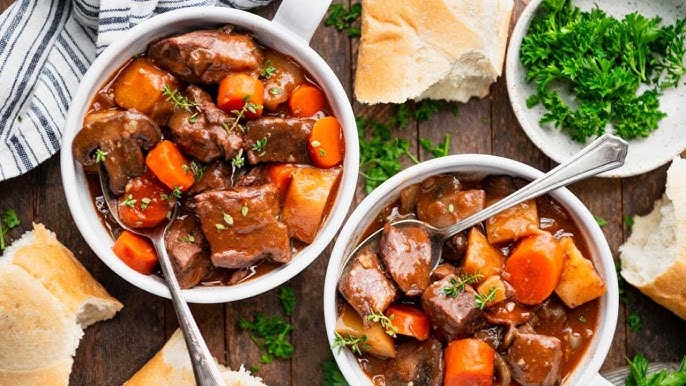Beef Burgundy Recipe: If you’re a fan of hearty, rich, slow-cooked meals, then Beef Burgundy, or Boeuf Bourguignon as it’s called in France, is bound to become your new favorite. It’s a comforting, savory stew that brings together beef, red wine, herbs, and vegetables in a way that turns simple ingredients into a culinary masterpiece. Whether you’re cooking for your family or planning a dinner party, this dish never fails to impress.
The beauty of Beef Burgundy lies in its simplicity paired with elegance. You don’t need to be a Michelin-star chef to pull this off. All it takes is a bit of patience, the right ingredients, and a willingness to enjoy the process.
Let’s dive into the flavorful world of Beef Burgundy with a detailed, step-by-step guide that’ll have you cooking like a French chef in no time.
What is Beef Burgundy?
History and Origin
Beef Burgundy hails from the Burgundy region of France, a place known not just for its exquisite wines but also for this iconic stew. Traditionally known as Boeuf Bourguignon, it was once considered a humble peasant dish, designed to make tough cuts of meat tender and flavorful through slow cooking in wine. Over time, it rose through the ranks of French cuisine, becoming a celebrated dish in both rustic homes and fine dining establishments.
The original versions were far more rudimentary, using basic ingredients and lots of time. As French cuisine evolved, so did Beef Burgundy. Today, it’s a staple in French kitchens and an international symbol of rich, slow-cooked comfort food.
Key Features of the Dish
What sets Beef Burgundy apart is its rich depth of flavor. The beef is first seared for a caramelized crust, then slowly braised in a full-bodied red wine with garlic, onions, mushrooms, and herbs. The long cooking time allows all the flavors to blend beautifully, creating a dish that’s incredibly tender and satisfying.
Another defining trait is the use of Burgundy wine—hence the name. While other red wines can work, the use of a good Pinot Noir from Burgundy brings authenticity and complexity to the stew.
Essential Ingredients
Getting the right ingredients is half the battle. The quality of your meat and wine directly impacts the final taste. Here’s what you’ll need:
Meat Selection Tips
The best beef cuts for this recipe are those with a good amount of marbling and connective tissue, which break down beautifully during slow cooking. Think chuck roast, brisket, or shoulder. Avoid lean cuts as they tend to dry out during long braising.
Here’s what to look for:
- 2 to 3 lbs of beef chuck roast, cut into 2-inch cubes
- Visible marbling for flavor
- Firm texture, not mushy or overly fatty
Pro tip: Ask your butcher for stew beef from the chuck or brisket—it saves you prep time and ensures the right cut.
Wine – The Star Ingredient
You can’t make Beef Burgundy without red wine, and not just any red wine will do. A bold, dry red wine like a Pinot Noir or even a Côtes du Rhône works beautifully. If you’re going for authenticity, try to find a bottle from Burgundy. The wine should be drinkable on its own, as this flavor will carry through the entire dish.
Other must-have ingredients include:
- 1 bottle (750 ml) of red wine
- 2 tbsp tomato paste
- 3 cups beef broth
- 1 bay leaf
- Fresh thyme
- 3 cloves of garlic
- 1 lb pearl onions (or small diced yellow onions)
- 1/2 lb carrots, chopped
- 1/2 lb mushrooms, quartered
- Salt and pepper to taste
Don’t skimp on fresh herbs—they elevate the flavor exponentially.
Tools You’ll Need
To make your cooking smooth and efficient, keep these tools handy:
- Large Dutch oven or heavy-bottomed pot
- Sharp chef’s knife
- Cutting board
- Wooden spoon
- Tongs
- Measuring cups and spoons
- Skillet (for browning meat and vegetables)
A Dutch oven is ideal because it retains and distributes heat evenly, which is crucial for braising. If you don’t have one, a deep oven-safe pot with a tight-fitting lid works just as well.
Prepping for the Recipe
Cutting and Marinating the Beef
Start by cutting your beef into uniform 2-inch cubes. This helps in even cooking. Some chefs like to marinate the beef overnight in wine and aromatics, but this step is optional.
To marinate:
- Place beef cubes in a large bowl
- Add half a bottle of red wine
- Toss in 2 garlic cloves, a bay leaf, and a few sprigs of thyme
- Cover and refrigerate overnight
This deepens the flavor, making the beef even more succulent. If you’re short on time, skipping this step won’t ruin the dish—it just won’t have that extra layer of richness.
Prepping Vegetables and Herbs
Chop your carrots, peel the pearl onions (or dice regular ones), and clean and quarter the mushrooms. Mince your garlic and keep your herbs tied in a bundle using kitchen twine for easy removal later (this is called a bouquet garni in French cooking).
Once everything is prepped and ready to go, you’re set to begin the actual cooking process.
Step-by-Step Cooking Instructions
Browning the Beef
This step is crucial—it builds the foundational flavor of your Beef Burgundy. Take your time and don’t overcrowd the pan.
- Heat a tablespoon of oil in your Dutch oven over medium-high heat.
- Pat the beef dry with paper towels (this helps achieve a good sear).
- Brown the beef cubes in batches, turning to ensure a golden crust on all sides.
- Set aside the browned beef on a plate.
Why not brown everything at once? Overcrowding leads to steaming instead of searing. You want that rich, brown crust—it adds depth and complexity.
Deglazing and Simmering
After browning, you’ll have browned bits stuck to the pot—that’s pure flavor.
- Lower the heat slightly, and add a splash of wine to the pot.
- Scrape the bottom with a wooden spoon to release those flavorful bits (this is called deglazing).
- Add in your chopped onions, carrots, and garlic.
- Sauté for about 5-7 minutes until they start to soften and pick up some color.
Next, stir in the tomato paste and cook for another 2 minutes to caramelize slightly. This enhances the overall richness of the stew.
Now it’s time to add the beef back into the pot:
- Pour in the rest of the wine and enough beef broth to just cover the meat.
- Add your herb bundle (thyme, bay leaf) and season with salt and pepper.
Bring the mixture to a gentle simmer. Let it bubble softly—not boil—so the flavors meld slowly and beautifully.
Slow Cooking for Flavor
Once simmering, you have two options:
- Oven Method: Cover the Dutch oven and place it in a preheated 325°F (160°C) oven for 2.5 to 3 hours.
- Stovetop Method: Simmer on low heat, covered, for the same amount of time.
Either way, check occasionally to ensure the liquid doesn’t evaporate too much. You want the beef to stay juicy and submerged.
About 45 minutes before it’s done, sauté the mushrooms separately in a pan with a bit of butter or oil until they’re golden brown. Add them to the stew.
Do the same with the pearl onions—brown them gently and add them toward the end to retain their shape and flavor.
Once the beef is fork-tender and the sauce has thickened slightly, you’re ready to serve.
Perfect Pairings with Beef Burgundy
Ideal Wine Pairings
Since wine is central to this dish, pairing it with the right wine makes the meal sing.
Top choices include:
- Pinot Noir (preferably from Burgundy)
- Merlot
- Côtes du Rhône
- Cabernet Franc
These wines complement the richness of the dish without overpowering it. If you used one for cooking, it’s a good rule of thumb to drink the same one during the meal.
Side Dishes That Complement
Beef Burgundy is hearty, so the sides should be simple yet capable of soaking up that velvety sauce. Some favorites:
- Creamy mashed potatoes – the ultimate comfort combo.
- Buttered noodles – a traditional French choice.
- Crusty French bread – perfect for mopping up the sauce.
- Polenta – adds a slightly sweet contrast.
- Roasted root vegetables – carrots, parsnips, and turnips complement the dish’s earthy flavors.
Keep the sides understated. Let the beef stew remain the star of the show.
Tips for Success
When it comes to cooking Beef Burgundy, success lies in the little details. While the process isn’t overly complicated, a few expert tips can elevate your dish from good to extraordinary.
- Dry the Beef Before Searing: Always pat your beef dry with paper towels before browning. Moisture on the surface will create steam, preventing a proper sear. A good sear locks in juices and creates flavor-packed brown bits that deepen the stew’s taste.
- Don’t Rush the Browning: Brown your beef in small batches. It’s tempting to speed things up, but crowding the pot results in steaming rather than searing. This is your flavor foundation—make it count.
- Use Quality Wine: The wine you choose can make or break the dish. Avoid “cooking wines” and opt for something you’d enjoy drinking. A good bottle of Pinot Noir or Burgundy wine brings authenticity and flavor depth.
- Slow and Low is the Way to Go: Rushing the cooking process won’t work here. Low heat and time transform the meat into something magical. Use a heavy-bottomed pot with a tight lid to ensure even heat distribution and moisture retention.
- Add Mushrooms and Onions Later: Cooking them separately ensures they don’t get mushy or overcooked. It also adds another layer of texture and visual appeal to the final dish.
- Let It Rest Before Serving: Just like with roasts, letting your stew sit for 15–20 minutes before serving allows the flavors to meld even more.
Common Mistakes to Avoid
Even the most seasoned cooks can slip up with Beef Burgundy. Here’s a rundown of common pitfalls—and how to avoid them.
Using the Wrong Cut of Beef
Opt for well-marbled, tough cuts like chuck roast. Avoid lean cuts like sirloin or tenderloin, which can dry out during the long cooking process. The fat and connective tissue in tougher cuts melt beautifully, giving the dish its signature richness.
Choosing the Wrong Wine
Don’t grab the cheapest bottle on the shelf. While you don’t need a $50 bottle, you want something that’s drinkable and medium-bodied. Stay away from overly sweet wines—they’ll throw off the balance of the dish.
Skipping the Browning Step
It may seem tedious, but skipping this step robs your dish of depth and complexity. Browning builds flavor—it’s absolutely worth the extra few minutes.
Overcooking the Vegetables
Root vegetables and mushrooms can turn to mush if added too early. Sauté and add them in the final hour of cooking for perfect texture and flavor.
Undercooking
On the flip side, don’t pull your stew too early. The beef should be fork-tender and the sauce slightly thickened. Undercooked meat will be chewy and bland.
Variations and Twists
Beef Burgundy is a traditional dish, but that doesn’t mean you can’t get creative. Here are a few ways to switch things up:
Add Bacon for Smokiness
Many French chefs begin this recipe by sautéing lardons (thick bacon strips). This adds a deep, smoky note that complements the wine and beef beautifully.
Try a White Wine Version
Swap red wine for white, and you’ve got a lighter twist known as Coq au Vin Blanc. Try it with chicken or pork for a whole new flavor profile.
Vegetarian Alternative
Craving the richness of Beef Burgundy but following a plant-based diet? Use portobello mushrooms, seitan, or jackfruit, and substitute wine and vegetable broth for the base.
Spice it Up
Though not traditional, adding a pinch of smoked paprika or chili flakes gives the dish a warming kick without overpowering it.
Cooking is art—don’t be afraid to add your signature twist.
Storing and Reheating Leftovers
Beef Burgundy stores and reheats like a dream. In fact, it might taste even better the next day!
Storing
- Allow the dish to cool completely before storing.
- Place in an airtight container and refrigerate for up to 4 days.
- For longer storage, freeze in individual portions for up to 3 months.
Reheating
- Reheat gently on the stovetop over low heat until warmed through.
- You can also microwave in short bursts, stirring in between.
- If the sauce has thickened too much, add a splash of broth or water to loosen it up.
Make sure it reaches an internal temperature of at least 165°F (74°C) before serving.
Health and Nutrition Info
While Beef Burgundy is a rich and hearty dish, it can still be a part of a balanced diet when prepared thoughtfully. Understanding the nutritional breakdown helps you enjoy it guilt-free.
Calories and Macros (per serving)
On average, one serving of Beef Burgundy contains:
- Calories: 450–600 (depending on serving size and side dishes)
- Protein: 35–45g
- Fat: 20–30g (mostly from beef and oil)
- Carbohydrates: 10–20g (mostly from vegetables and wine)
- Fiber: 3–5g
Tips for Making It Healthier
If you’re watching your waistline or aiming for a healthier version, here are a few tweaks:
- Trim excess fat from the beef before cooking.
- Use olive oil or avocado oil instead of butter.
- Increase vegetable quantity to add more fiber and vitamins.
- Opt for low-sodium beef broth to reduce salt content.
- Serve with steamed greens or whole grains like quinoa instead of mashed potatoes or bread.
Though Beef Burgundy is often thought of as indulgent, these smart swaps let you enjoy it more often without compromising on taste.
Serving Suggestions
Presentation matters, even for a rustic stew. When plated thoughtfully, Beef Burgundy becomes a feast for the eyes as well as the palate.
How to Serve
- In a shallow bowl to contain the rich sauce.
- Garnish with fresh herbs like chopped parsley or thyme.
- Add a spoonful of crème fraîche for a creamy contrast (optional but elegant).
Best Accompaniments
The dish itself is rich and saucy, so it’s best served with something that absorbs and balances that depth:
- Mashed potatoes – creamy and classic.
- Rustic French bread – for sopping up the sauce.
- Buttered egg noodles – silky and satisfying.
- Polenta or grits – for a Southern twist.
- Rice or wild rice – adds texture and fiber.
If you’re going for a full French experience, consider serving with a simple green salad tossed in vinaigrette and a glass of Pinot Noir.
FAQs about Beef Burgundy Recipe
1. Can I make Beef Burgundy in a slow cooker?
Absolutely! Brown the meat and vegetables first, then transfer everything to your slow cooker. Cook on low for 7–8 hours or high for 4–5 hours.
2. What can I substitute for red wine in Beef Burgundy?
If you prefer not to use alcohol, substitute with a mix of beef broth, grape juice, and a tablespoon of red wine vinegar or balsamic vinegar for depth.
3. Can I use chicken instead of beef?
Yes, but the dish becomes a variation called Coq au Vin. Follow similar steps using chicken thighs and a slightly shorter cooking time.
4. Why is my Beef Burgundy bitter?
This often happens if the wine is overly tannic or hasn’t been cooked long enough to mellow out. Always use a good quality, medium-bodied wine and allow enough cooking time.
5. How do I thicken the sauce?
If the sauce is too thin, remove the lid and simmer for 15–20 minutes to reduce. You can also mix a tablespoon of flour with softened butter (beurre manié) and stir it into the sauce.
Final Thoughts
Beef Burgundy isn’t just a dish—it’s an experience. It’s the kind of meal that brings people together, warms your home with its aroma, and tells a story of tradition, patience, and love for food. From the first sear of the beef to the final sip of wine, every step of the process is a chance to connect with the roots of French cooking.
Whether you’re making it for Sunday dinner, a special date night, or simply to try something new, this recipe will not disappoint. Take your time, enjoy each step, and don’t be afraid to make it your own. Because once you’ve mastered the art of Beef Burgundy, it becomes more than a recipe—it becomes a treasured ritual.



